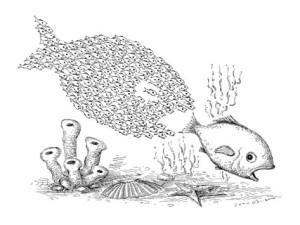 Loosely following the theme of last week’s post, it’s now fairly well established that humans tend to pick on the big species first.
Loosely following the theme of last week’s post, it’s now fairly well established that humans tend to pick on the big species first.
From fewer big trees, declines of big carnivores, elephant & rhino poaching, to fishing down the web, big species tend to cop it hardest when it comes to human-caused ecological disturbance.
While there are a lot of different combinations of traits that make some species more vulnerable to extinction than others (see examples for legumes, amphibians, sharks & teleosts, and mammals), one of the main ones is species size.
Generally speaking, larger species tend to produce fewer offspring and breed later in life than smaller species. This means that despite larger species tending to live longer than their smaller counterparts, their ‘slow’ reproductive output means that they are generally more susceptible to rapid environmental change (mainly via human intervention). In other words, their capacity for self-replacement is often too low to counteract the offtake from direct exploitation or habitat loss.
Despite a reasonable scientific understanding of this extinction-risk principle, the degree to which human disturbance affects species’ distributions is much less well quantified, and this is especially true for marine species.
I’m proud to announce another fascinating paper led by my postdoc, Camille Mellin, that has just come out online in Nature Communications: Humans and seasonal climate variability threaten large-bodied coral reef fish with small ranges.
With the world’s largest combined dataset of coral reef fish surveys for the entire Indo-Pacific (including the coral reef fish biodiversity hotspot — the Coral Triangle), we examined which conditions best described the distribution of fishes over a range of body sizes.
The distribution and coexistence of species are of course dictated by many things: food availability (energy), biogeography, habitat availability, predation, climate, disturbance, etc., etc., so it was necessary to capture as much of these as possible when looking for drivers. I’ll let you read the (open access) paper to get the full complexity of the drivers and models we considered.
The take home message was pretty straight-forward though — human pressure and ‘energy’ (temperature seasonality) were important drivers only for big species, whereas small species’ distributions were best explained by biogeographical correlates (reef area). Basically, human pressure suppresses the distribution of big species, but smaller species are relatively insensitive to anthropogenic disturbances.
Why this is rather exciting (in my humble opinion) is that it’s one of the first broad-scale demonstrations of how humans have altered large marine species’ distributions and not just their abundances or threat risks. We now have a tool to map which species are most susceptible to range degradation and shrinkage across a huge section of the world’s oceans.
Hopefully we’ll have enough foresight to limit actual extinctions once we see ranges starting to shrink.
CJA Bradshaw

